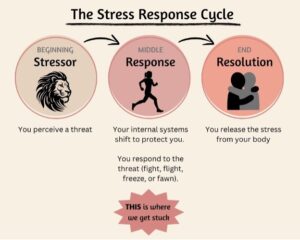Are you stuck in a stress cycle?
Are you stuck in a stress cycle?
We live in a fast-paced, information-saturated world, making it nearly impossible to go through a day without feeling stressed. Whether it is simply your commute or something as big as racism, stressors are everywhere. Stressors activate the stress cycle in our bodies, and research shows that chronic stress has negative health impacts – physically and mentally. When we get stuck in this cycle, stress hangs around longer than needed, causing worse outcomes.
First, let’s define some terms.
Stressors are the things in your life that make you feel overwhelmed, anxious, or activated in some way. They are potential threats. They are commonly external (like capitalism, the news, or work) however they can also be internal (like negative self-talk or your trauma history).
Stress is how your body responds to the stressor. Stress is the physiological and neurological changes that happen in your body as a result of the stressor. This is an evolutionary response designed to keep you alive.
The stress cycle is a biological process triggered by stressors. It has a beginning, middle, and end.
- It begins with the initial activation – increased heart rate, blood pressure, and cortisol levels.
- The middle phase is how you respond to the stressor – fight, flight, freeze, or fawn.
- The end is returning to a calm, restored state.
Completing this full cycle is important for well-being, as it allows the body to regulate itself and return to a state of homeostasis.
To paint a clearer picture, let’s look at a classic example – being chased by a lion.
Here, the lion represents the stressor – the threat. When the lion begins to run towards you, your stress response is activated. Your body responds instinctively: adrenaline surges, blood pumps into your muscles, and the focus shifts to survival. Somehow you make it to your house, run inside, and lock the door before the lion gets to you. You feel relieved, you cry and hug your family. You are safe.
In this example, you move all the way through the entire stress cycle – from threat to response to safety. In more modern examples, like a challenging phone call, we can fail to take actions to arrive at the stage of resolution, leaving us in the middle of the cycle with the stress remaining stuck inside our bodies.

The stress response cycle is here to keep us alive by responding to immediate threats. The only problem is that our modern stressors are typically not life-threatening, yet our bodies react as if they are. So, we have this wonderful system in place to keep us alive, but it is getting activated by things that will not kill us. Our physical safety is not at risk yet our body is filtering these situations as life or death. As such, we need to meet our bodies where they are and help them remember – you are safe now, let’s turn off all the alarms and return to rest.
How to complete the stress cycle?
This isn’t about solving any problems or making the stressor go away. This is all about finding a way to communicate to your body that it is safe and it survived the stressful situation.
- Physical activity – running, shaking, walking, dancing
- Intentional breathing – make your exhale longer than your inhale
- Positive social interactions – talking with a friend
- Authentic laughter
- Affection – 20-second hug from someone you trust
- A good cry
- Creative expression
My personal favorites are running, singing, crying, and shaking. Anything that gets my heart pumping a little bit faster is usually what works for me.
As the Nagoski sisters say in their book Burnout: The Secret to Unlocking the Stress Cycle, “stress is not the problem”. The problem is when we do not release the stress from our bodies. “The goal isn’t to live in a state of perpetual balance and peace and calm; the goal is to move through stress to calm, so that you’re ready for the next stressor, and to move from effort to rest and back again.”
While stressors are inevitable in our lives, how we respond to these stressors is within our control. By integrating these cycle-completing activities into our routines, we can effectively manage our stress, promoting a healthier mind and body.
Next time you find yourself feeling stressed, ask yourself, how can I allow this stress to be released from my system? How can I show my body that it is safe?
References:
Nagoski, E., & Nagoski, A. (2019). Burnout: the secret to unlocking the stress cycle. First edition. New York, Ballantine Books.

